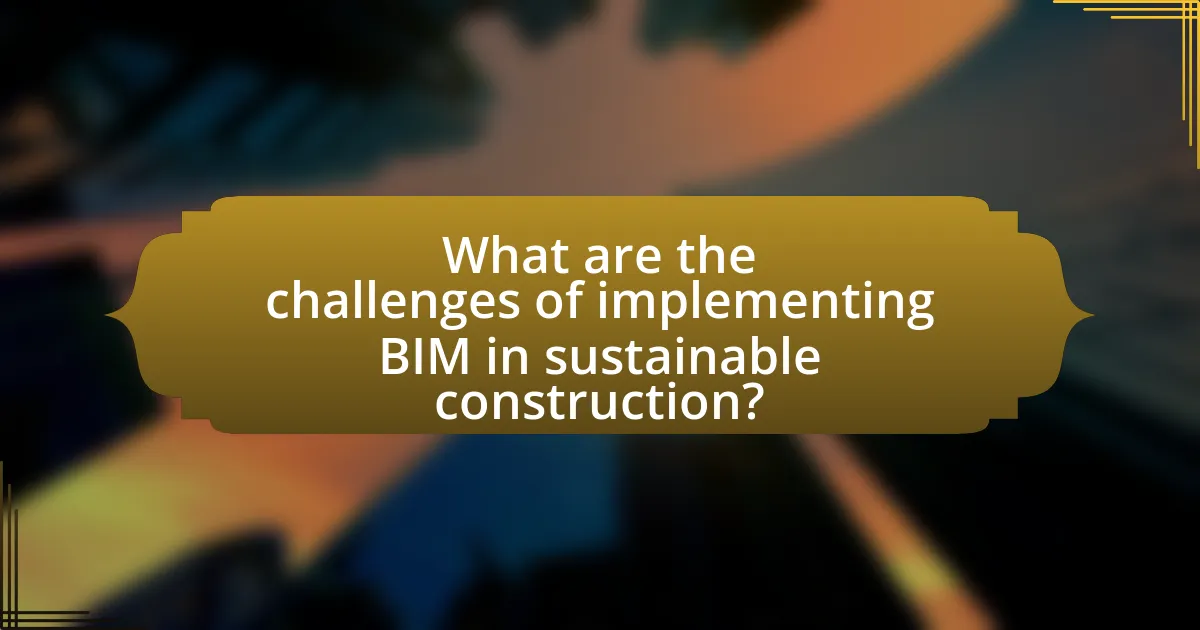Building Information Modeling (BIM) is a digital representation of a facility’s physical and functional characteristics that plays a crucial role in sustainable construction. This article explores how BIM enhances sustainability by improving resource management, reducing waste, and optimizing energy performance throughout a building’s lifecycle. Key features of BIM, such as enhanced visualization, energy analysis, and lifecycle assessment, contribute to more efficient construction practices. Additionally, the article addresses the challenges of implementing BIM, including high initial costs and the need for skilled personnel, while highlighting future trends and the potential impacts of advanced technologies like artificial intelligence and cloud computing on sustainable construction practices.
-in-the-context-of-Sustainable-Construction-1.webp)
What is Building Information Modeling (BIM) in the context of Sustainable Construction?
Building Information Modeling (BIM) in the context of Sustainable Construction is a digital representation of physical and functional characteristics of a facility that supports decision-making throughout its lifecycle. BIM enhances sustainability by enabling efficient resource management, reducing waste, and optimizing energy performance during design, construction, and operation phases. For instance, a study by the National Institute of Building Sciences indicates that BIM can reduce project costs by up to 20% and construction time by 7%, contributing to more sustainable practices in the built environment.
How does BIM contribute to sustainability in construction projects?
BIM contributes to sustainability in construction projects by enabling efficient resource management and reducing waste. Through its digital modeling capabilities, BIM allows for precise planning and visualization, which leads to optimized material usage and minimized energy consumption during construction. For instance, a study by the National Institute of Building Sciences found that implementing BIM can reduce project costs by up to 20% and construction waste by 30%. This efficiency not only lowers the environmental impact but also enhances the overall sustainability of the construction process.
What are the key features of BIM that promote sustainable practices?
The key features of Building Information Modeling (BIM) that promote sustainable practices include enhanced visualization, energy analysis, and lifecycle assessment capabilities. Enhanced visualization allows stakeholders to better understand design implications, leading to more informed decisions that prioritize sustainability. Energy analysis tools integrated within BIM enable the simulation of energy consumption and optimization of building performance, which can reduce operational energy use by up to 30%. Lifecycle assessment capabilities facilitate the evaluation of environmental impacts throughout a building’s lifespan, promoting materials selection and construction methods that minimize waste and carbon footprint. These features collectively support sustainable construction by improving efficiency, reducing resource consumption, and fostering environmentally responsible design choices.
How does BIM facilitate energy efficiency in building design?
BIM facilitates energy efficiency in building design by enabling precise modeling and analysis of energy consumption throughout the building lifecycle. This technology allows architects and engineers to simulate various design scenarios, assess energy performance, and optimize building systems before construction begins. For instance, studies have shown that using BIM can lead to a reduction in energy use by up to 30% through improved design decisions and better integration of renewable energy sources. Additionally, BIM supports the use of energy analysis tools that provide real-time feedback on energy efficiency, allowing for adjustments that enhance sustainability.
Why is BIM important for the future of sustainable construction?
BIM is important for the future of sustainable construction because it enhances efficiency, reduces waste, and promotes better resource management throughout the building lifecycle. By utilizing a digital representation of physical and functional characteristics, BIM allows for precise planning and collaboration among stakeholders, which leads to optimized designs that minimize environmental impact. Studies indicate that projects using BIM can reduce construction waste by up to 30% and improve energy efficiency by enabling better analysis of building performance. This data-driven approach supports sustainable practices, making BIM a crucial tool for achieving long-term sustainability goals in the construction industry.
What role does BIM play in reducing waste during construction?
BIM plays a crucial role in reducing waste during construction by enabling precise planning and visualization of projects. This technology allows for accurate modeling of building components, which minimizes errors and miscalculations that often lead to material waste. According to a study published in the Journal of Cleaner Production, projects utilizing BIM can reduce waste by up to 30% due to improved coordination among stakeholders and enhanced project management. By facilitating better communication and collaboration, BIM ensures that resources are used efficiently, further contributing to waste reduction in the construction process.
How does BIM enhance collaboration among stakeholders in sustainable projects?
BIM enhances collaboration among stakeholders in sustainable projects by providing a centralized digital platform for information sharing and communication. This platform allows architects, engineers, contractors, and clients to access real-time data, facilitating informed decision-making and reducing misunderstandings. For instance, a study by Azhar et al. (2012) in the “Journal of Construction Engineering and Management” demonstrated that BIM improved project coordination and reduced conflicts by 30%, highlighting its effectiveness in fostering collaboration. Additionally, BIM’s visualization capabilities enable stakeholders to better understand project impacts on sustainability, aligning their goals and strategies more effectively.

What are the challenges of implementing BIM in sustainable construction?
The challenges of implementing Building Information Modeling (BIM) in sustainable construction include high initial costs, lack of skilled personnel, and resistance to change within organizations. High initial costs arise from the investment in software, training, and technology required for effective BIM integration. The lack of skilled personnel is a significant barrier, as many professionals in the construction industry may not have the necessary training or experience with BIM tools. Resistance to change is often observed in organizations that are accustomed to traditional construction methods, making it difficult to adopt new technologies like BIM. These challenges can hinder the effective utilization of BIM, which is essential for enhancing sustainability in construction projects.
What technical barriers exist in the adoption of BIM for sustainability?
Technical barriers in the adoption of Building Information Modeling (BIM) for sustainability include interoperability issues, lack of standardized protocols, and insufficient training for users. Interoperability challenges arise when different software systems cannot effectively communicate, hindering data exchange and collaboration among stakeholders. The absence of standardized protocols complicates the integration of sustainability metrics into BIM processes, making it difficult to assess environmental impacts consistently. Additionally, many professionals lack adequate training in BIM tools and sustainable practices, limiting their ability to leverage BIM for sustainability goals. These barriers collectively impede the effective implementation of BIM in sustainable construction projects.
How can training and education improve BIM implementation?
Training and education significantly enhance BIM implementation by equipping professionals with the necessary skills and knowledge to effectively utilize BIM tools and processes. A well-trained workforce can improve collaboration, reduce errors, and streamline project workflows, leading to more efficient project delivery. According to a study by the National Institute of Building Sciences, organizations that invest in BIM training report a 20% increase in project efficiency and a 30% reduction in rework costs. This evidence underscores the critical role that targeted training and education play in maximizing the benefits of BIM in sustainable construction projects.
What are the costs associated with transitioning to BIM in construction?
The costs associated with transitioning to Building Information Modeling (BIM) in construction include software acquisition, training, and potential changes to workflows. Software licenses for BIM tools can range from several thousand to tens of thousands of dollars annually, depending on the complexity and scale of the projects. Training costs can also be significant, as firms may need to invest in professional development for employees, which can amount to thousands of dollars per employee. Additionally, transitioning to BIM may require modifications to existing processes and workflows, leading to temporary productivity losses during the adjustment period. According to a study by McGraw Hill Construction, 71% of firms reported increased costs during the initial transition phase, highlighting the financial implications of adopting BIM.
How can organizations overcome these challenges?
Organizations can overcome challenges in implementing Building Information Modeling (BIM) by investing in training and education for their workforce. This approach ensures that employees are proficient in BIM tools and methodologies, which enhances collaboration and efficiency in sustainable construction projects. A study by McGraw Hill Construction found that organizations that prioritize BIM training experience a 20% increase in project delivery speed and a 15% reduction in costs. Additionally, fostering a culture of collaboration among stakeholders, including architects, engineers, and contractors, can streamline communication and problem-solving, further mitigating challenges associated with BIM adoption.
What best practices can be adopted for successful BIM integration?
Successful BIM integration can be achieved by adopting best practices such as establishing clear project goals, fostering collaboration among stakeholders, and ensuring consistent data management. Clear project goals align the team’s efforts and expectations, which is essential for effective communication and decision-making. Collaboration among architects, engineers, contractors, and owners enhances the sharing of information and reduces conflicts, leading to more efficient workflows. Consistent data management ensures that all team members have access to up-to-date and accurate information, which is critical for maintaining the integrity of the BIM model throughout the project lifecycle. These practices are supported by industry studies, such as the National Institute of Building Sciences’ report, which highlights that effective collaboration and data management can significantly reduce project costs and timelines.
How can leadership support the transition to BIM in sustainable construction?
Leadership can support the transition to Building Information Modeling (BIM) in sustainable construction by fostering a culture of innovation and providing necessary resources for training and implementation. Effective leaders can advocate for the integration of BIM by emphasizing its benefits, such as improved collaboration, enhanced project efficiency, and reduced waste, which align with sustainability goals. Research indicates that organizations that prioritize leadership involvement in technology adoption experience a 30% higher success rate in implementation (McKinsey & Company, 2020). By actively engaging stakeholders, setting clear objectives, and allocating budget for BIM tools and training, leadership can facilitate a smoother transition and ensure that sustainable practices are embedded within the BIM framework.

What are the future trends of BIM in sustainable construction?
The future trends of Building Information Modeling (BIM) in sustainable construction include increased integration of artificial intelligence, enhanced data analytics for energy efficiency, and a focus on lifecycle assessment. These trends are driven by the need for more efficient resource management and reduced environmental impact in construction projects. For instance, AI can optimize design processes by predicting energy consumption patterns, while advanced data analytics can provide insights into material sustainability and waste reduction. Additionally, lifecycle assessment tools within BIM can help stakeholders evaluate the environmental impact of building materials and construction methods over time, promoting more sustainable choices.
How is technology evolving to enhance BIM for sustainability?
Technology is evolving to enhance Building Information Modeling (BIM) for sustainability through the integration of advanced data analytics, artificial intelligence, and cloud computing. These technologies enable real-time data processing and analysis, allowing for more accurate modeling of energy consumption, material usage, and environmental impact. For instance, AI algorithms can optimize design choices by simulating various scenarios to identify the most sustainable options, while cloud computing facilitates collaboration among stakeholders, ensuring that sustainability goals are met throughout the project lifecycle. Additionally, the use of IoT sensors in conjunction with BIM allows for continuous monitoring of building performance, leading to improved energy efficiency and reduced waste. This evolution is supported by studies indicating that projects utilizing enhanced BIM technologies can achieve up to 30% reductions in energy consumption compared to traditional methods.
What role do artificial intelligence and machine learning play in BIM?
Artificial intelligence and machine learning enhance Building Information Modeling (BIM) by improving data analysis, automating design processes, and optimizing project management. These technologies enable predictive analytics, which helps in forecasting project outcomes and identifying potential risks early in the construction process. For instance, AI algorithms can analyze historical project data to inform decision-making, leading to more efficient resource allocation and reduced costs. Additionally, machine learning can automate repetitive tasks, such as clash detection and design validation, thereby increasing productivity and accuracy in BIM workflows.
How can cloud computing improve BIM collaboration and data sharing?
Cloud computing enhances BIM collaboration and data sharing by providing a centralized platform for real-time access to project data. This allows multiple stakeholders, including architects, engineers, and contractors, to collaborate seamlessly from different locations, reducing delays and miscommunication. For instance, a study by McKinsey & Company found that cloud-based collaboration can improve project delivery speed by up to 20%. Additionally, cloud computing supports version control and data integrity, ensuring that all team members work with the most current information, which is crucial for effective decision-making in sustainable construction projects.
What are the potential impacts of BIM on sustainable construction practices?
Building Information Modeling (BIM) significantly enhances sustainable construction practices by improving resource efficiency, reducing waste, and optimizing energy performance. BIM facilitates precise planning and visualization, allowing for better decision-making regarding materials and construction methods, which leads to minimized environmental impact. For instance, a study by Azhar et al. (2011) found that BIM can reduce project costs by up to 20% and construction waste by 30% through improved coordination and clash detection. Additionally, BIM supports energy analysis and simulation, enabling designers to create buildings that consume less energy and utilize renewable resources effectively. This integration of sustainability metrics into the design process demonstrates BIM’s critical role in advancing eco-friendly construction methodologies.
How can BIM influence regulatory compliance and green building certifications?
BIM can significantly influence regulatory compliance and green building certifications by providing accurate data and visualization tools that facilitate adherence to building codes and sustainability standards. Through its detailed modeling capabilities, BIM allows for the simulation of energy performance, material usage, and environmental impact, which are critical for meeting regulatory requirements and achieving certifications such as LEED or BREEAM. For instance, a study by Azhar et al. (2011) in the “Journal of Construction Engineering and Management” demonstrated that BIM enhances compliance by enabling real-time analysis of design alternatives against regulatory frameworks, thus streamlining the certification process.
What are the long-term benefits of using BIM for sustainable construction?
The long-term benefits of using Building Information Modeling (BIM) for sustainable construction include enhanced resource efficiency, reduced waste, and improved energy performance. BIM facilitates precise planning and visualization, allowing for better decision-making regarding materials and construction methods, which leads to a decrease in resource consumption. According to a study by McGraw Hill Construction, projects utilizing BIM can achieve up to a 30% reduction in material waste. Additionally, BIM supports energy analysis and simulation, enabling the design of buildings that optimize energy use, which can result in energy savings of 20-30% over the building’s lifecycle. These benefits contribute to lower operational costs and a reduced environmental impact, aligning with sustainable construction goals.
What practical steps can construction professionals take to leverage BIM for sustainability?
Construction professionals can leverage Building Information Modeling (BIM) for sustainability by integrating energy analysis tools within the BIM framework. This integration allows for the assessment of energy consumption and carbon emissions during the design phase, enabling informed decisions that reduce environmental impact. For instance, a study by the National Institute of Building Sciences found that using BIM can lead to a 20% reduction in energy use through optimized building designs. Additionally, professionals can utilize BIM for lifecycle assessment, which evaluates the environmental impact of materials and construction methods over the building’s lifespan, further promoting sustainable practices.

Leave a Reply